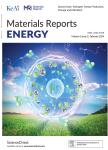Interface passivation engineering for hybrid perovskite solar cells
作者机构:Foshan Xianhu Laboratory of the Advanced Energy Science and Technology Guangdong LaboratoryFoshan528216Guangdong ProvincePR China State Key Laboratory of Advanced Technology for Materials Synthesis and ProcessingWuhan University of TechnologyWuhan430070PR China
出 版 物:《Materials Reports(Energy)》 (材料导报(能源)(英文))
年 卷 期:2021年第1卷第4期
页 面:22-33页
核心收录:
学科分类:080903[工学-微电子学与固体电子学] 0809[工学-电子科学与技术(可授工学、理学学位)] 08[工学] 0807[工学-动力工程及工程热物理] 080501[工学-材料物理与化学] 0805[工学-材料科学与工程(可授工学、理学学位)] 080502[工学-材料学]
基 金:the National Key Research and Development Plan(2017YFE0131900,2019YFE0107200) National Natural Science Foundation of China(52072284) the Fundamental Research Funds for the Central Universities(WUT:202443004) the Technological Innovation Key Project of Hubei Province(2018AAA048) .J.Z.thanks the support the“Chutian Scholar Program”of Hubei Province,China
主 题:Perovskite solar cells Charges recombination Interface passivation engineering Hysteresis effect PSCs stability Solution processes Vacuum evaporation
摘 要:The allure of high efficiency and low-temperature solution-processed organic-inorganic hybrid perovskite solar cells(PSCs)are inspiring scientists to seek for its *** passivation engineering has become an effective way to further enhance the efficiency and stability of PSCs by defect passivation,reduces the charge recombination and ion migration initiation and hysteresis control,***,we have summarized the effects and recent research progress of interface passivation engineering in *** passivation layers can be realized by using the solution and/or vacuum evaporation processes which are very adaptable to varied materials with different properties and fabrication processes for enhanced photovoltaic performance and stability.



